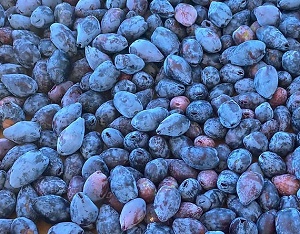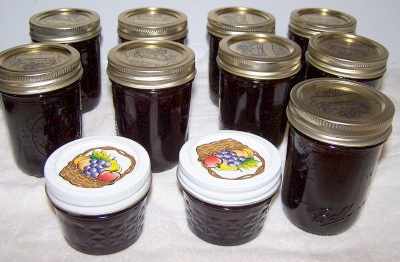
Warning: include(../orchardfiles/introcrop-haskap.php): failed to open stream: No such file or directory in /home/picky2/public_html/haskap-orchards/CNONottawane-haskaps.php on line 107
Warning: include(): Failed opening '../orchardfiles/introcrop-haskap.php' for inclusion (include_path='.:/opt/cpanel/ea-php71/root/usr/share/pear') in /home/picky2/public_html/haskap-orchards/CNONottawane-haskaps.php on line 107
Haskap U-Pick Orchards in Northeast Ottawa, Ontario in 2024, by county
Below are the U-Pick orchards and farms for haskaps that we know of in this area. Not all areas of any state, nor even every state, have haskaps orchards that are open to the public. If you know of any others, please tell us using the add a farm form!
Remember to always check with the farm's own website or Facebook page before you go - or call or email them if they don't have a website or Facebook page. Conditions at the farms and crops can change literally overnight, so if you want to avoid a wasted trip out there - check with the farm directly before you go! If I cannot reach them, I DON'T GO!
PLEASE report closed farms, broken links and incorrect info using the "Report Corrections" form below.
Prescott and Russell (Alfred, Casselman, Clarence-Rockland, Embrun, Hawkesbury, Van Kleek Hill)
- La ferme Les Fruits du Poirier - Aronia berries, apples, pears, plums, gooseberries, northern kiwi, haskaps, Black Raspberries, Honey from hives on the farm, Yellow Raspberries, Saskatoons Berries aka serviceberries, Raspberries, Gooseberries, Jostaberry aka Casseilles, Red Currants, Black Currants, chokeberries, Table grapes, blackberries, Sea buckthorn aka argousier
2535 Concession 3, St-Eugene, ON K0B 1P0. Phone: 514-792-3599. Email: lesfruitsdupoirier@ropoirier.com. Open: the season is usually from mid-June through mid-October, please see their website or call for hours and availability. Directions: . Click here for a map and directions. . facebook page. Nous cultivons une variété de petits fruits (vedette: camerise / haskap) selon des pratiques de cultu. (ADDED: February 14, 2023, JBS)
Haskaps and Honeyberries
Haskap Picking Tips, Recipes and Information

What are they, where to find them and how to use them
Haskaps are similar to, but not related to blueberries, but they are oblong berries that are blue! They are actually related to honeysuckle,(Lonicera caerulea) and go by other names. Haskaps and honeyberries commonly considered to be the same plant, but while they are related and both are found in the honeysuckle family (Caprifoliaceae) they are divided into different subspecies. But unless you are a scientist, you'll probably never know the difference. .
Taste and description
- They are edible with an unusual sweet and tart flavor, described as a cross between raspberries and blueberries. The flavor is varies, from sour to bland to more sweet and sometimes like huckleberries.
- The berries range in size from less than half a gram to nearly two grams.
- They are shrubs that typically grow to a height of 3 to 5 feet (1 to 1.5 m.). The plant produces a 1-inch (2.5 cm.), oblong, blue-colored berry.
- They are said to have a higher level of antioxidants and Vitamin C than blueberries
- Each plant produces 1 lb to 10 lbs of berries annually and the plants live 50 years plus.
- Since they are resistant to both disease and pests, they are ideal for organic gardening
Where are Haskaps grown?
Haskaps are native to cool temperate Northern Hemisphere areas such as Alaska, the northern Midwestern states, Canada, Japan, Russia, and Poland. Of course, they may also be grown in similar climates to which they are not native. They are very cold-hardy and can survive temperatures down to -55 degrees Fahrenheit (-48 C.).
You can get your own haskap plants to grow in your yard here.
Popular Varieties of Haskaps
- Blue Lightning - from Russia, a heavy producer with dark blue berries that are sweet and tart,
- Borealis - considered to be one of the best tasting haskap varieties with large fruit
- Indigo Gem - a smaller, more tart variety, also a very heavy producer, but it is susceptible to powdery mildew.
- Kamchatka - also from Russia, this variety produces large, dark blue fruit in heavy crops.
- Tundra - used in commercial production because the fruit is very firm and the plant is resistant to powdery mildew .
To find farms with Haskaps (also called Honeyberries!) see below:
Alaska
Minnesota
Missouri
Pennsylvania
Canada
Alberta
- Edmonton area of Alberta,
-
Search Results
Web results
Southwest Alberta
British Columbia
Manitoba
Ontario
Saskatchewan
When are Haskaps ripe?
Haskaps are ripe in the early Spring, far ahead of blueberries and Saskatoons. Keep in mind, the actual ripening dates and even the order can vary considerably from farm to farm, year to year, state to state; so take this as general order!
Other names for Haskaps
- honeyberries
- blue-berried honeysuckle,
- Fly honeysuckle,
- deepblue honeysuckle, and
- sweetberry honeysuckle
Berries that are similar to Haskaps
- Aroniaberries - also callled Chokecherries
- Bilberries - smaller cousins of the blueberry in Europe
- Blaeberry in Scotland and Ireland, smaller, intense flavor; like a bilberry-
- Huckleberries - larger blueberries, a bit less sweet, common to the northern US and Canada
- Saskatoons - Canadians know about Saskatoons. They are native to western Canada and the northwest of the U.S.. They are larger, a bit less sweet; almost identical to a Huckleberry, with a hint of apple.
- Serviceberries - another name for Saskatoons
- Whorlberry or whortleberry grown in the United Kingdom. Much like a bilberry.
Haskap Recipes - Cooking and Canning Haskaps
Being similar in many ways to blueberries, most blueberry recipes work well with Haskaps.
- The world's best Blueberry pie, recipe and directions and illustrated!
- Blueberry buckle coffee cake: illustrated directions for this great crumb-topping blueberry coffee cake
- Other easy directions to make blueberry desserts: cobblers, etc.
Canning and freezing Haskaps:

- How to Freeze Blueberries
- How to Can Blueberries
- How to Make Homemade Blueberry Jam
- How to make blueberry jelly
- How to make and can blueberry syrup (it works for strawberries, raspberries and blackberries, too)
- blueberry pie filling to use later,
- blueberry butter
Other Local Farm Products (Honey, Horses, Milk, Meat, Eggs, Etc.)
(NOT pick-your-own, unless they are also listed above)
- Farm markets and roadside stands
- Local Honey Finder
- Local Meat, Milk and Eggs
- Venues: Farms, Wineries, Orchards for your event, wedding or party
- Easter egg hunts
- Children"s consignment sales
- Fruit and vegetable festivals
- Winery tours and wine tastings
- Horse rides, stables, lessons, trails
- Maple Syrup farms and sugarworks
- Bed & Breakfasts on Farms, Wineries, Ranches and Orchards
- Pumpkin patches
- Corn mazes
- Zombie Paintball venues
- Christmas Tree Farms & lots
- Environmental resources
- Consumer fraud information
- Wholesale food sources
- Resources for Farmers
Looking for canning equipment and supplies?
Water bath canner with a jar rack
Pressure canners for gas, electric and induction stoves: Presto 23Qt or T-fal 22Qt
Canning scoop (this one is PERFECT)
Ball Blue book (most recent version)
Find Other types of farms:
Farm markets and roadside stands
Road trips and camping resources
Local Honey, apiaries, beekeepers
Consumer fraud and scams information
Home canning supplies at the best prices on the internet!
Maple Syrup Farms, sugarworks, maple syrup festivals
Environmental information and resources
Farms For Your Event for birthday parties, weddings, receptions, business meetings, retreats, etc.
Festivals - local fruit and vegetable festivals
Get the
most recent version of
the Ball Blue Book
With this Presto 23 quart pressure canner and pressure cooker, you can "can" everything, fruits, vegetables, jams, jellies, salsa, applesauce, pickles, even meats, soups, stews. Model 01781

You can make jams, jellies, can fruit, applesauce, salsa and pickles with water bath canners, like this Granite Ware 12-Piece Canner Kit, Jar Rack, Blancher, Colander and 5 piece Canning Tool Set

